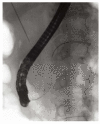Pancreatic duct guidewire placement for biliary cannulation in a single-session therapeutic ERCP
- PMID: 21528077
- PMCID: PMC3082752
- DOI: 10.3748/wjg.v17.i15.1989
Pancreatic duct guidewire placement for biliary cannulation in a single-session therapeutic ERCP
Abstract
Aim: To investigate the technical success and clinical complication rate of a cannulated pancreatic duct with guidewire for biliary access.
Methods: During a five-year study period, a total of 2843 patients were included in this retrospective analysis. Initial biliary cannulation method consisted of single-guidewire technique (SGT) for up to 5 attempts, followed by double-guidewire technique (DGT) when repeated unintentional pancreatic duct cannulation had taken place. Pre-cut papillotomy technique was reserved for when DGT had failed or no pancreatic duct cannulation had been previously achieved. Main outcome measurements were defined as biliary cannulation success and post-endoscopic retrograde cholangiopancreatography (ERCP) complication rate.
Results: SGT (92.3% success rate) was characterized by statistically significant enhanced patient outcome compared to either the DGT (43.8%, P < 0.001), pre-cut failed DGT (73%, P < 0.001) or pre-cut as first step method (80.6%, P = 0.002). Pre-cut as first step method offered a statistically significantly more favorable outcome compared to the DGT (P < 0.001). The incidence of post-ERCP pancreatitis did not differ in a statistically significant manner between either method (SGT: 5.3%, DGT: 6.1%, Pre-cut failed DGT: 7.9%, Pre-cut as first step: 7.5%) or with patients' gender.
Conclusion: Although DGT success rate proved not to be superior to SGT or pre-cut papillotomy, it is considered highly satisfactory in terms of safety in order to avoid the risk of a pre-cut when biliary therapy is necessary in difficult-to-cannulate cases.
Keywords: Endoscopic retrograde cholangiopancreatography; Pancreatic duct; Post-endoscopic retrograde cholangiopancreatography pancreatitis; Pre-cut papillotomy.
Figures


Similar articles
-
Clinical usefulness of double-guidewire technique for difficult biliary cannulation in endoscopic retrograde cholangiopancreatography.Dig Endosc. 2014 May;26(3):442-9. doi: 10.1111/den.12158. Epub 2013 Aug 12. Dig Endosc. 2014. PMID: 23937334
-
Comparison of sequential pancreatic duct guidewire placement technique and needle knife precut sphincterotomy for difficult biliary cannulation.J Dig Dis. 2015 Dec;16(12):741-6. doi: 10.1111/1751-2980.12300. J Dig Dis. 2015. PMID: 26562073
-
Double guidewire technique vs transpancreatic precut sphincterotomy in difficult biliary cannulation.World J Gastroenterol. 2013 Jan 7;19(1):108-14. doi: 10.3748/wjg.v19.i1.108. World J Gastroenterol. 2013. PMID: 23326171 Free PMC article. Clinical Trial.
-
Management of difficult or failed biliary access in initial ERCP: A review of current literature.Clin Res Hepatol Gastroenterol. 2019 Aug;43(4):365-372. doi: 10.1016/j.clinre.2018.09.004. Epub 2018 Oct 9. Clin Res Hepatol Gastroenterol. 2019. PMID: 30314736 Review.
-
Selective biliary cannulation techniques for endoscopic retrograde cholangiopancreatography procedures and prevention of post- endoscopic retrograde cholangiopancreatography pancreatitis.Expert Rev Gastroenterol Hepatol. 2016 Jun;10(6):709-22. doi: 10.1586/17474124.2016.1143774. Epub 2016 Feb 6. Expert Rev Gastroenterol Hepatol. 2016. PMID: 26782710 Review.
Cited by
-
Needle-knife fistulotomy vs double-guidewire technique in patients with repetitive unintentional pancreatic cannulations.World J Gastroenterol. 2015 May 21;21(19):5918-25. doi: 10.3748/wjg.v21.i19.5918. World J Gastroenterol. 2015. PMID: 26019456 Free PMC article.
-
Intraprocedural quality in endoscopic retrograde cholangiopancreatography: a meta-analysis.Am J Gastroenterol. 2013 Nov;108(11):1696-704; quiz 1705. doi: 10.1038/ajg.2013.217. Epub 2013 Jul 23. Am J Gastroenterol. 2013. PMID: 23877349 Free PMC article.
-
Impact of periampullary diverticulum on biliary cannulation and ERCP outcomes: a single-center experience.Surg Endosc. 2021 Nov;35(11):5953-5961. doi: 10.1007/s00464-020-08080-8. Epub 2020 Oct 7. Surg Endosc. 2021. PMID: 33029732
-
A Prospective Multicenter Randomized Feasibility Trial of Double-guidewire Techniques for Difficult Biliary Cannulation Comparing a New Double-guidewire-supported Sphincterotome (MagicTome) to a Conventional Device.Intern Med. 2022 Feb 1;61(3):291-301. doi: 10.2169/internalmedicine.7367-21. Epub 2021 Aug 6. Intern Med. 2022. PMID: 34373374 Free PMC article. Clinical Trial.
-
Efficacy of a modified double-guidewire technique using an uneven double lumen cannula (uneven method) in patients with surgically altered gastrointestinal anatomy (with video).Surg Endosc. 2020 Mar;34(3):1432-1441. doi: 10.1007/s00464-019-07228-5. Epub 2019 Oct 30. Surg Endosc. 2020. PMID: 31667613
References
-
- Freeman ML, Guda NM. ERCP cannulation: a review of reported techniques. Gastrointest Endosc. 2005;61:112–125. - PubMed
-
- NIH state-of-the-science statement on endoscopic retrograde cholangiopancreatography (ERCP) for diagnosis and therapy. NIH Consens State Sci Statements. 2002;19:1–26. - PubMed
-
- Cortas GA, Mehta SN, Abraham NS, Barkun AN. Selective cannulation of the common bile duct: a prospective randomized trial comparing standard catheters with sphincterotomes. Gastrointest Endosc. 1999;50:775–779. - PubMed
-
- Lella F, Bagnolo F, Colombo E, Bonassi U. A simple way of avoiding post- ERCP pancreatitis. Gastrointest Endosc. 2004;59:830–834. - PubMed
-
- Artifon EL, Sakai P, Cunha JE, Halwan B, Ishioka S, Kumar A. Guidewire cannulation reduces risk of post-ERCP pancreatitis and facilitates bile duct cannulation. Am J Gastroenterol. 2007;102:2147–2153. - PubMed
MeSH terms
LinkOut - more resources
Full Text Sources
Medical

